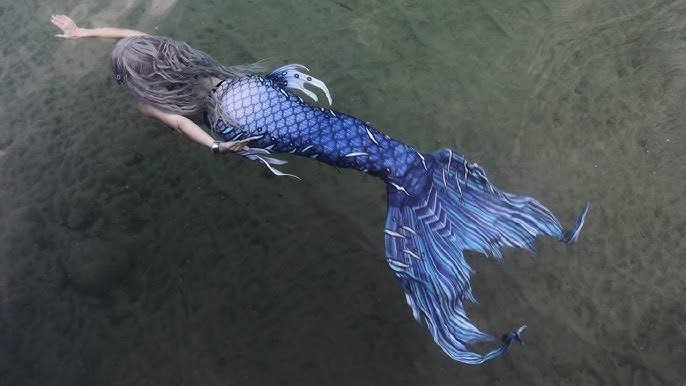How to Care for Your Mermaid Tail to Extend Its Lifespan

Caring for your mermaid tail is essential to ensure it lasts as long as possible while maintaining its performance. Regular maintenance not only prevents damage from elements like salt water and chlorine but also keeps the tail looking and functioning at its best. By following proper care routines, you can enjoy a longer-lasting tail without the need for frequent replacements. The following sections will outline key steps to help you care for your mermaid tail effectively.
Rinsing After Every Use
Taking care of your Mermaid Dress starts with a simple but crucial step: rinsing it after every swim. Whether you’ve been in saltwater or a chlorinated pool, rinsing your tail helps remove elements that could wear down the material over time. Regular rinsing is an easy habit that will extend the life of your tail. Here’s how to rinse your mermaid tail properly:
- Use Fresh, Cool Water
Always use fresh, cool water to rinse your tail. This helps get rid of salt, chlorine, or any other chemicals that might stick to the fabric and cause damage. - Rinse the Zipper Area
Pay close attention to the zipper (if your tail has one). Make sure it’s free of sand and salt, as these can affect its function over time. - Turn the Tail Inside Out
Rinse both the inside and outside of the tail. Turning the tail inside out allows you to clean areas that are in direct contact with your skin and might collect sweat or sunscreen. - Avoid Harsh Water Pressure
Use a gentle stream of water to rinse the tail. Strong water pressure can stretch or weaken the fabric over time, especially around the seams. - Shake Off Excess Water
After rinsing, gently shake the tail to remove excess water. This helps speed up the drying process and prevents mold or mildew from forming. - Inspect for Residue
Run your hands along the entire surface of the tail to make sure no sand, salt, or other debris remains stuck, especially in creases and seams. - Don’t Forget the Monofin
If your tail has a monofin, remove it and rinse it separately to clear out any sand or debris that might be trapped inside.
Rinsing your mermaid tail after every use is an easy yet important habit that will keep your tail in top condition. With proper care, you can ensure it stays vibrant and functional for many swims to come.
Proper Storage Methods
Storing your mermaid tail the right way is key to keeping it in good condition when not in use. Proper storage can prevent damage, wrinkles, and unnecessary wear, helping your tail last longer. Follow these steps to ensure your tail stays safe between swims:
- Store in a Cool, Dry Place
Keep your mermaid tail in a cool, dry spot away from direct sunlight. Heat and sun can fade the colors and weaken the material over time. - Lay the Tail Flat
When possible, lay your tail flat to avoid creases or folds. If space is limited, gently roll it, but never fold it tightly as this can cause permanent creases. - Use a Breathable Storage Bag
Store the tail in a breathable fabric bag to protect it from dust while allowing airflow. Avoid using plastic bags, as they can trap moisture and lead to mold. - Keep the Monofin Separate
If your mermaid tail has a monofin, store it separately or remove it when storing the tail. This prevents any unnecessary pressure on the tail’s fabric. - Avoid Heavy Items on Top
Ensure that nothing heavy is placed on top of the tail to avoid crushing it. The weight can stretch or distort the fabric. - Check for Dampness Before Storing
Always make sure your tail is completely dry before putting it away. Storing a damp tail can cause mildew and weaken the material.
By following these storage tips, you can make sure your mermaid tail stays in great condition, ready for your next swim. Proper storage will extend its lifespan and help maintain its look and performance.
Cleaning Your Mermaid Tail
Cleaning your mermaid tail regularly is important to keep it looking fresh and to maintain its quality. With the right cleaning methods and following Mermaid Tail Care Tips you can prevent damage and ensure your tail stays in great condition for many swims.
- Hand Wash Only
Always hand wash your mermaid tail in cool water. Machine washing can damage the fabric or cause it to lose its shape. - Use Mild Soap
Choose a mild, gentle soap to clean your tail. Harsh detergents or bleach can weaken the material and fade the colors. - Soak, Don’t Scrub
Soak your tail in water with soap for a few minutes. Avoid scrubbing, as this can cause the fabric to wear out faster. - Rinse Thoroughly
Make sure to rinse the tail completely to remove all soap. Leftover soap can cause the fabric to break down over time. - Avoid Wringing the Fabric
After washing, gently squeeze out excess water instead of wringing the fabric. Wringing can stretch the material and damage it. - Air Dry in Shade
Lay your mermaid tail flat to dry in a shaded area. Never use a dryer or place it in direct sunlight, as heat can damage the fabric.
By cleaning your mermaid tail the right way, you’ll keep it looking great and ready for your next swim. Regular care will ensure it stays durable and vibrant for a long time.
Inspect for Damage Regularly
Regularly inspecting your mermaid tail for damage is essential to keeping it in good condition. Small issues can turn into bigger problems if left unchecked, so it’s important to spot them early.
- Check the Seams
Look closely at the seams to make sure there are no loose threads or signs of tearing. If you notice anything, it’s best to fix it right away to prevent further damage. - Examine the Fabric
Run your hands over the fabric to feel for any weak spots or thinning areas. These spots could lead to holes if not addressed soon. - Inspect the Zipper
If your tail has a zipper, check to ensure it works smoothly without getting stuck. Sand or debris can clog the zipper, so clean it regularly to avoid damage. - Look for Small Tears
Check for small rips or tears in the fabric, especially near high-stress areas like the foot pockets or waist. Small repairs now can save you from bigger issues later. - Check the Monofin
If your tail includes a monofin, inspect it for cracks or damage. A broken monofin can affect the performance of your tail and may even lead to further wear.
By inspecting your mermaid tail regularly, you can catch any damage early and prevent it from worsening. This simple step can keep your tail in top shape and extend its lifespan.
Avoiding Harsh Surfaces
Protecting your mermaid tail from harsh surfaces is a simple way to prevent damage. Rough or sharp surfaces can cause tears and wear down the fabric, so it’s important to be mindful of where you use your tail.
- Avoid Rough Pool Decks
Pool edges and decks can be rough and abrasive. When taking a break, sit on a towel or mat to protect your tail from scratches. - Steer Clear of Rocks or Gravel
If you’re swimming in natural bodies of water, avoid rocky areas or places with gravel. These surfaces can easily tear the fabric or cause snags. - Be Careful on Sand
While sand may seem soft, it can still scratch the surface of your tail over time. Rinse your tail off immediately after swimming in sandy areas to prevent buildup. - Use Swim Mats
Consider bringing a swim mat or towel with you to sit or lie on when you’re out of the water. This gives your tail an extra layer of protection. - Watch Out for Pool Ladders
Be cautious when using pool ladders, as the edges can be sharp and cause tears in the fabric if you’re not careful.
Avoiding harsh surfaces is a simple but effective way to protect your mermaid tail. By taking these steps, you can keep your tail in good condition and avoid unnecessary damage.
Maintaining the Shape and Fit
Keeping your Adult Mermaid Tail in the right shape and fit is important for both comfort and performance. Over time, improper care can cause the tail to lose its form, so it’s essential to maintain it properly.
- Store the Tail Flat
Always store your mermaid tail flat to prevent creases and folds that can affect its shape. If space is tight, gently roll it instead of folding. - Avoid Stretching the Fabric
Be mindful of how you handle the tail when putting it on and taking it off. Stretching the fabric too much can cause it to lose its elasticity and proper fit. - Adjust Padding if Necessary
If your tail has padding or inserts, make sure they are properly adjusted. This will ensure the tail fits well and doesn’t lose its shape. - Check the Waist and Foot Pockets
Over time, the waist and foot pockets may loosen. Regularly check these areas to make sure they fit snugly, and make adjustments as needed. - Handle with Care During Washing
When washing your tail, avoid wringing or twisting the fabric, as this can distort its shape. Gently squeeze out excess water instead.
Maintaining the shape and fit of your mermaid tail will help it stay comfortable and perform well for a long time. Taking a few simple steps can go a long way in keeping your tail in top condition.
Knowing When to Replace the Tail
No matter how well you care for your mermaid tail, it will eventually show signs of wear. Knowing when to replace your tail is important to ensure safety and comfort while swimming.
- Fading Colors
If the colors of your mermaid tail have faded significantly, it might be time to consider a replacement. Fading can weaken the fabric and affect its overall look. - Severe Tears or Rips
Small tears can often be repaired, but if your tail has large rips or multiple holes, it’s best to get a new one to avoid further damage. - Worn-Out Fabric
Over time, the fabric may become thin or lose its elasticity. If the material feels weak or overly stretched, it won’t provide the same fit and support. - Damaged Monofin
A cracked or broken monofin can affect your swimming performance. If the monofin no longer functions properly, replacing the tail may be necessary. - Uncomfortable Fit
If your tail no longer fits well, despite adjustments, it’s a sign that the shape has been lost. A poor fit can make swimming difficult and uncomfortable.
Recognizing when it’s time to replace your mermaid tail ensures you continue to swim safely and comfortably. A new tail will give you the best experience and performance in the water.
Proper care is key to extending the life of your mermaid tail and keeping it in great condition. From rinsing after every use to knowing when it’s time to replace the tail, following these steps will help you enjoy your tail for many swims to come. By making these simple care routines part of your regular practice, you can ensure your tail stays vibrant, comfortable, and ready for your next adventure.



